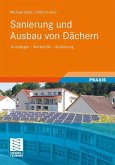Often described as the "fifth façade", the flat roof is extremely popular with architects. Its essential task is to shelter the space beneath it from the elements. Beyond this, the use of flat roofs may be optimized by integrating them as green roofs, roof terraces, circulation areas, and even productive solar roofs. In practice, however, their correct and professional realization is a highly exacting task: in addition to providing the planner with basic rules of construction and design, the Flat Roof Manual also supplies an overview of the use and construction types as well as the standard assemblies for flat roofs. Together with the most important standards and bodies of regulations, construction drawings of the principal connection points round out the volume.
Das Flachdach - dieser bei Architekten beliebte und gerne als fünfte Fassade beschriebene Gebäudeteil - sollte im Wesentlichen den darunter liegenden Raum vor Witterungseinflüssen schützen. Darüber hinaus optimiert die Integration flacher Dächer als Gründach, Dachterrasse, Verkehrsfläche oder gar als ertragreiches Solardach den Nutzen. Die fachgerechte Realisierung in der Praxis ist jedoch anspruchsvoll: Der Flachdach Atlas verschafft dem Planer neben grundsätzlichen Konstruktionsregeln einen Überblick über die Nutzungs- und Konstruktionsarten sowie die Regelaufbauten für Flachdächer. Zusammen mit den wichtigsten Normen und Regelwerken runden Konstruktionsdarstellungen der wesentlichen Anschlusspunkte die Publikation ab.
Das Flachdach - dieser bei Architekten beliebte und gerne als fünfte Fassade beschriebene Gebäudeteil - sollte im Wesentlichen den darunter liegenden Raum vor Witterungseinflüssen schützen. Darüber hinaus optimiert die Integration flacher Dächer als Gründach, Dachterrasse, Verkehrsfläche oder gar als ertragreiches Solardach den Nutzen. Die fachgerechte Realisierung in der Praxis ist jedoch anspruchsvoll: Der Flachdach Atlas verschafft dem Planer neben grundsätzlichen Konstruktionsregeln einen Überblick über die Nutzungs- und Konstruktionsarten sowie die Regelaufbauten für Flachdächer. Zusammen mit den wichtigsten Normen und Regelwerken runden Konstruktionsdarstellungen der wesentlichen Anschlusspunkte die Publikation ab.


